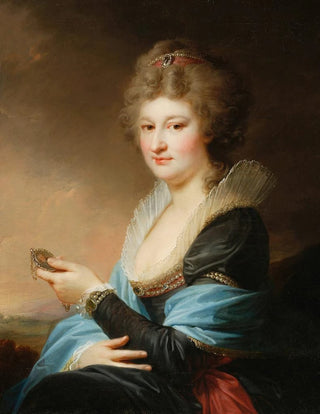Art print | Portrait of Józefa née Radziwiłł 1762-before 1816 - Johann Baptist von Lampi the Elder


View from behind

Frame (optional)
Portrait of Józefa née Radziwiłł 1762-avant 1816 - Johann Baptist von Lampi l'Ancien – Captivating introduction
The portrait of Józefa née Radziwiłł, created by Johann Baptist von Lampi l'Ancien, serves as an open window into the 18th century, a time when art and nobility intertwined harmoniously. This painting, which captures the essence of a woman from Polish high society, evokes feelings of grace and dignity. As viewers contemplate this work, they are transported to a universe where every detail, every shade of color, tells a story. Lampi's art, both precise and poetic, allows us to grasp not only the appearance of his model but also her spirit and social status.
Style and uniqueness of the work
Johann Baptist von Lampi's style is characterized by remarkable finesse and meticulous attention to detail. In the portrait of Józefa, light plays a fundamental role, delicately illuminating the young woman's face and emphasizing the softness of her features. The garments, richly decorated, testify to exceptional craftsmanship and refined taste, typical of the aristocracy of the time. The colors, carefully chosen, range between soft tones and more vivid shades, creating a captivating visual balance. This painting is not just a simple portrait; it is a true work of art that transcends time, capturing the essence of an era while revealing the personality of its subject. The composition, skillfully orchestrated, invites the viewer to lose themselves in the details, explore the subtleties of expression, and feel the depth of Józefa's soul.
The artist and his influence
Johann Baptist von Lampi l'Ancien, of Austrian origin, established himself as one of the most prominent portraitists of his time. Primarily active in Poland, he managed to fuse Central European artistic influences with local traditions, creating a unique style. His ability to capture the essence of his subjects, through natural poses and authentic expressions, marked his era and influenced many artists who followed him. Lampi did not merely paint

Matte finish

View from behind

Frame (optional)
Portrait of Józefa née Radziwiłł 1762-avant 1816 - Johann Baptist von Lampi l'Ancien – Captivating introduction
The portrait of Józefa née Radziwiłł, created by Johann Baptist von Lampi l'Ancien, serves as an open window into the 18th century, a time when art and nobility intertwined harmoniously. This painting, which captures the essence of a woman from Polish high society, evokes feelings of grace and dignity. As viewers contemplate this work, they are transported to a universe where every detail, every shade of color, tells a story. Lampi's art, both precise and poetic, allows us to grasp not only the appearance of his model but also her spirit and social status.
Style and uniqueness of the work
Johann Baptist von Lampi's style is characterized by remarkable finesse and meticulous attention to detail. In the portrait of Józefa, light plays a fundamental role, delicately illuminating the young woman's face and emphasizing the softness of her features. The garments, richly decorated, testify to exceptional craftsmanship and refined taste, typical of the aristocracy of the time. The colors, carefully chosen, range between soft tones and more vivid shades, creating a captivating visual balance. This painting is not just a simple portrait; it is a true work of art that transcends time, capturing the essence of an era while revealing the personality of its subject. The composition, skillfully orchestrated, invites the viewer to lose themselves in the details, explore the subtleties of expression, and feel the depth of Józefa's soul.
The artist and his influence
Johann Baptist von Lampi l'Ancien, of Austrian origin, established himself as one of the most prominent portraitists of his time. Primarily active in Poland, he managed to fuse Central European artistic influences with local traditions, creating a unique style. His ability to capture the essence of his subjects, through natural poses and authentic expressions, marked his era and influenced many artists who followed him. Lampi did not merely paint






